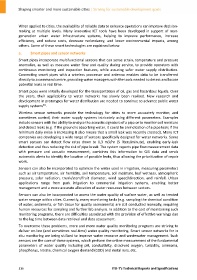Page 526 - Shaping smarter and more sustainable cities - Striving for sustainable development goals
P. 526
When applied to cities, the availability of reliable data to enhance operations can improve decision‐
making at multiple levels. Many innovative ICT tools have been developed in support of next‐
generation urban water infrastructure systems, helping to improve performance, increase
efficiency, and reduce costs, decrease redundancy, and lower environmental impacts, among
others. Some of these smart technologies are explained below:
a. Smart pipes and sensor networks
Smart pipes incorporate multifunctional sensors that can sense strain, temperature and pressure
anomalies, as well as measure water flow and quality during service, to provide operators with
continuous monitoring and inspection features, while assuring safer water supply distribution.
Connecting smart pipes with a wireless processor and antenna enables data to be transferred
directly to a command centre, providing water managers with the tools needed to detect and locate
potential leaks in real time.
Smart pipes were initially developed for the transportation of oil, gas and hazardous liquids. Over
the years, their applicability to water networks has slowly been realized. New research and
development in prototypes for water distribution are needed to continue to advance public water
26
supply systems .
Wireless sensor networks provide the technology for cities to more accurately monitor, and
sometimes control, their water supply systems intricately using different parameters. Examples
include sensors with the ability to analyse the acoustic signature of a pipe or to monitor soil moisture
and detect leaks (e.g. if the ground is absorbing water, it could be an indication of a pipe leak; if the
minimum daily noise is increasing it also means that a small leak was recently created). Many ICT
companies are developing a wide range of sensors specifically designed for water networks. Some
smart sensors can detect flow rates down to 0,3 m3/hr (5 liters/minute), enabling early‐leak
detection and thus reducing the risk of pipe break. The system reports pipe flow measurement data
with pressure and acoustic measurement, combines this information to GIS data and sends
automatic alerts to identify the location of possible leaks, thus allowing the prioritization of repair
work.
Sensors can also be incorporated to optimize the water used in irrigation, measuring parameters
such as air temperature, air humidity, soil temperature, soil moisture, leaf wetness, atmospheric
pressure, solar radiation, trunk/stem/fruit diameter, wind speed/direction, and rainfall. Urban
applications range from park irrigation to commercial irrigation systems, enabling better
management and a more accurate allocation of water resources between sectors.
Sensors can also be incorporated to assess the water quality of surface water, as well as treated
water sewage within cities. Currently, many monitoring tasks (e.g. sampling the chemical condition
of water, sediments, or fish tissue for quality assessments) are still conducted manually, requiring
human resources for sampling and further lab analysis. In addition to the cost of maintaining such
monitoring programs, there are difficulties associated with the provision of effective warnings due
to the lag time between data retrieval and data assessment.
To overcome these problems, more and more water quality monitoring programs are striving to
deliver on‐line (and sometimes real‐time) water quality monitoring. Smart sensor networks for in
situ monitoring are being utilized to improve water resource and wastewater management. Such
sensors are the core of these systems, which perform the online measurement of the fundamental
parameters of water quality including pH, conductivity, dissolved oxygen, turbidity, ammonia,
phosphorus, nitrate, chemical oxygen demand (COD) and metal ions, etc.
516 ITU‐T's Technical Reports and Specifications

